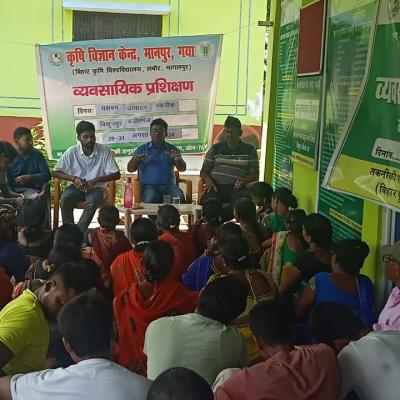
कृषि में पशुपालन का प्रभाव
............................................
पशुपालन सदियों से कृषि का अभिन्न अंग रहा है, जो ग्रामीण अर्थव्यवस्थाओं को बनाए रखने और आवश्यक संसाधन प्रदान करने में महत्वपूर्ण भूमिका निभाता है। NASP फार्मर प्रोड्यूसर कंपनी लिमिटेड जैसी संस्थाओं के लिए, प्रभावी पशुपालन को बढ़ावा देना कृषि उत्पादकता को बढ़ाने और किसानों का समर्थन करने के लिए आवश्यक है। आइए जानें कि पशुपालन कृषि को कैसे प्रभावित करता है।
1. आर्थिक लाभ
पशुपालन कृषि अर्थव्यवस्था में महत्वपूर्ण योगदान देता है, जिससे दूध, मांस, चमड़ा और अन्य उप-उत्पाद मिलते हैं। विशेष रूप से डेयरी फार्मिंग किसानों को स्थिर आय प्रदान करती है और खाद्य सुरक्षा को मजबूत करती है। इसके अलावा, पशुपालन प्रजनन, चारा उत्पादन, परिवहन और प्रसंस्करण उद्योगों में रोजगार के अवसर पैदा करता है।
2. मृदा उर्वरता और जैविक खेती
पशु गोबर एक प्राकृतिक उर्वरक है जो मिट्टी को आवश्यक पोषक तत्व प्रदान करता है और जैविक खेती को बढ़ावा देता है। रासायनिक उर्वरकों की तुलना में, पशु गोबर मिट्टी की संरचना में सुधार करता है, नमी बनाए रखने में मदद करता है और सूक्ष्मजीव गतिविधि को बढ़ावा देता है, जिससे कृषि भूमि अधिक उपजाऊ और टिकाऊ बनती है।
3. छोटे किसानों के लिए श्रम शक्ति
कई ग्रामीण क्षेत्रों में, पशु अब भी जुताई और माल ढुलाई के लिए श्रम शक्ति के रूप में कार्य करते हैं। यह महंगे मशीनरी और ईंधन पर निर्भरता को कम करता है, जिससे छोटे और सीमांत किसानों के लिए खेती अधिक किफायती हो जाती है।
4. टिकाऊ कृषि पद्धतियाँ
फसल उत्पादन के साथ पशुपालन को जोड़ना स्थायी कृषि को बढ़ावा देता है। मिश्रित खेती और चक्रीय चराई जैसी पद्धतियाँ पारिस्थितिक संतुलन बनाए रखने में मदद करती हैं, मिट्टी के कटाव को कम करती हैं और चरागाहों की गुणवत्ता में सुधार करती हैं। इसके अलावा, पशु कार्बन अवशोषण में योगदान देते हैं, जिससे जलवायु परिवर्तन के प्रभावों को कम किया जा सकता है।
5. डेयरी उद्योग में योगदान
डेयरी क्षेत्र कृषि जीडीपी में सबसे बड़े योगदानकर्ताओं में से एक है। पशुपालन दूध और डेयरी उत्पादों की निरंतर आपूर्ति सुनिश्चित करता है, जिससे विभिन्न व्यवसायों जैसे कि दूध प्रसंस्करण संयंत्र, पनीर उत्पादन और मिठाई उद्योगों को समर्थन मिलता है। उचित प्रबंधन के साथ, डेयरी फार्मिंग प्रोटीन युक्त भोजन उपलब्ध कराकर पोषण सुरक्षा को बढ़ाती है।
6. अपशिष्ट प्रबंधन और बायोगैस उत्पादन
पशु अपशिष्ट का कुशलतापूर्वक उपयोग बायोगैस उत्पादन के लिए किया जा सकता है, जिससे ग्रामीण परिवारों के लिए एक नवीकरणीय ऊर्जा स्रोत उपलब्ध होता है। बायोगैस संयंत्र जीवाश्म ईंधन पर निर्भरता को कम करने में मदद करते हैं, साथ ही जैविक खाद के रूप में उपयोग होने वाला अवशेष भी प्रदान करते हैं, जिससे कृषि में चक्रीय अर्थव्यवस्था बनती है।
7. किसानों की आजीविका में सुधार
कई छोटे किसानों के लिए पशुपालन आय का मुख्य स्रोत है। यह दूध उत्पादन, बछड़ों की बिक्री और उप-उत्पादों के माध्यम से एक स्थायी आय प्रदान करता है। इसके अलावा, NASP जैसी किसान उत्पादक कंपनियाँ पशुपालकों को बेहतर बाजार, पशु चिकित्सा सेवाओं और वित्तीय सहायता तक पहुँच प्रदान करने में महत्वपूर्ण भूमिका निभाती हैं।
निष्कर्ष
पशुपालन कृषि का एक महत्वपूर्ण आधार है, जो खाद्य सुरक्षा, आर्थिक स्थिरता और सतत कृषि पद्धतियों में योगदान देता है। NASP फार्मर प्रोड्यूसर कंपनी लिमिटेड जैसी संगठनों के समर्थन से, पशुपालकों को उन्नत संसाधन और आधुनिक तकनीक तक पहुँच मिल सकती है, जिससे उत्पादकता में वृद्धि होगी। पशुपालन में निवेश न केवल कृषि को सशक्त बनाता है बल्कि ग्रामीण समुदायों को दीर्घकालिक विकास के लिए भी सक्षम बनाता है।
NASP फार्मर प्रोड्यूसर कंपनी लिमिटेड नवाचार समाधान और टिकाऊ पशुपालन तकनीकों के माध्यम से कृषि पद्धतियों को उन्नत करने और किसानों का समर्थन करने के लिए प्रतिबद्ध है।
 English
English  Hindi
Hindi 







